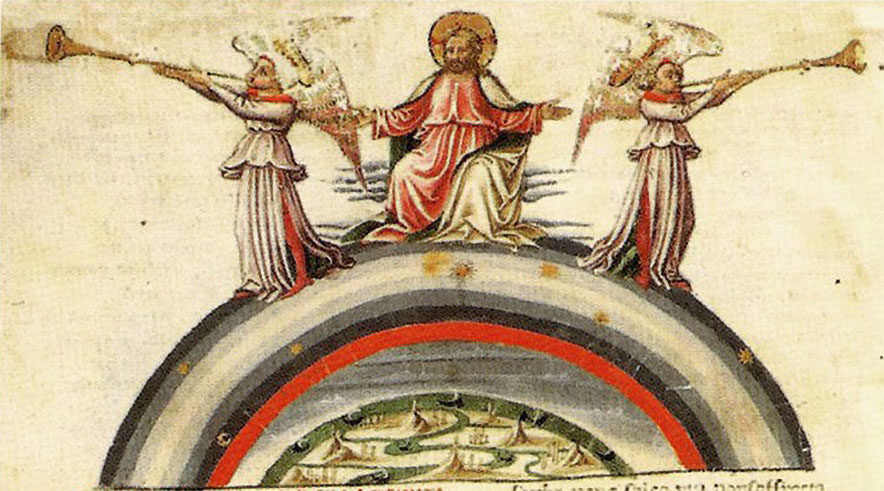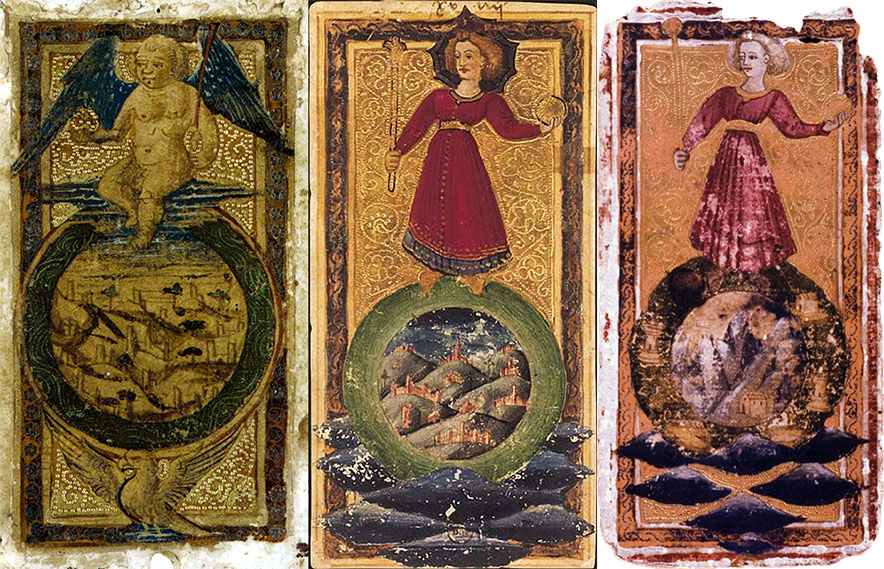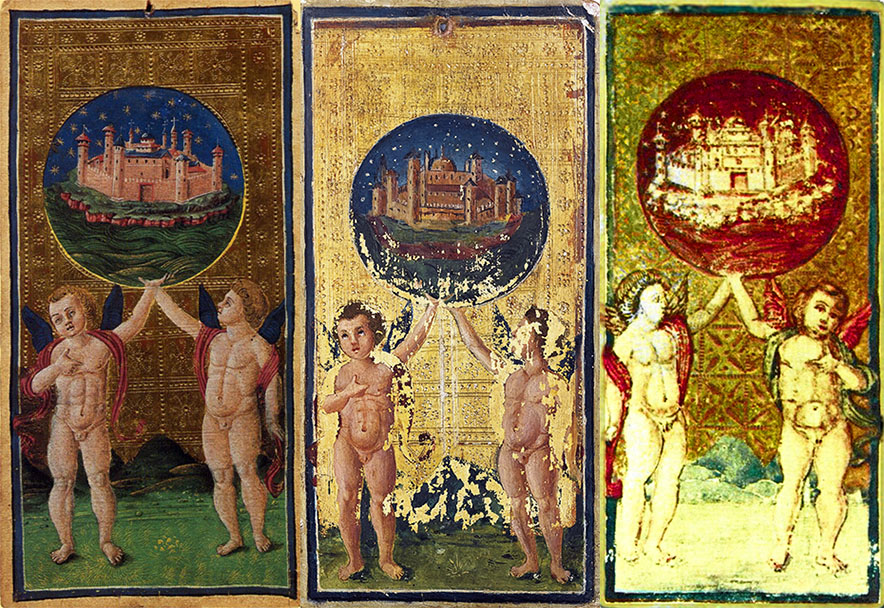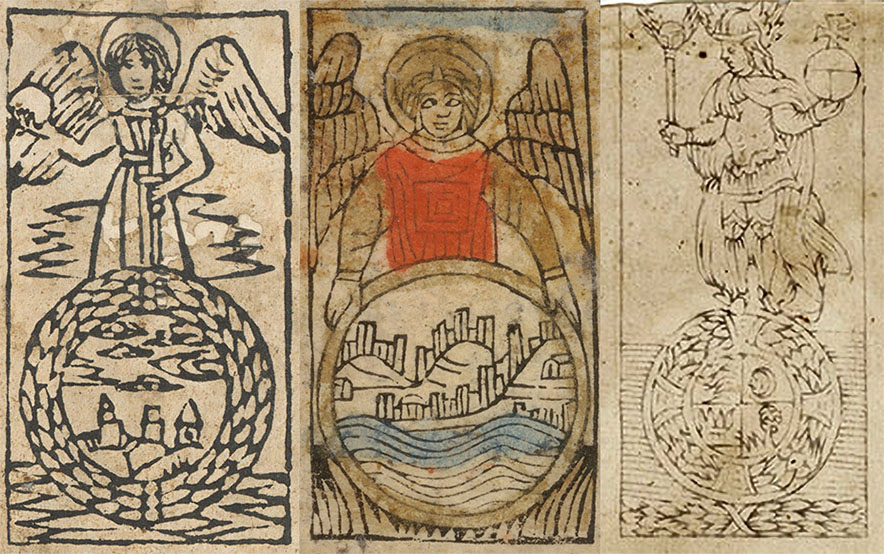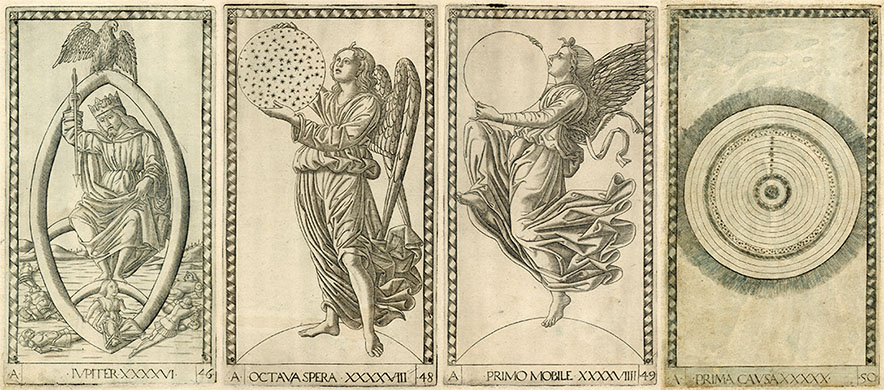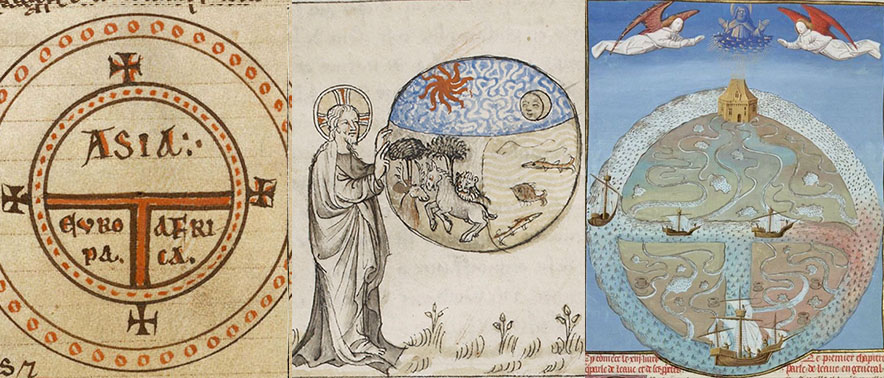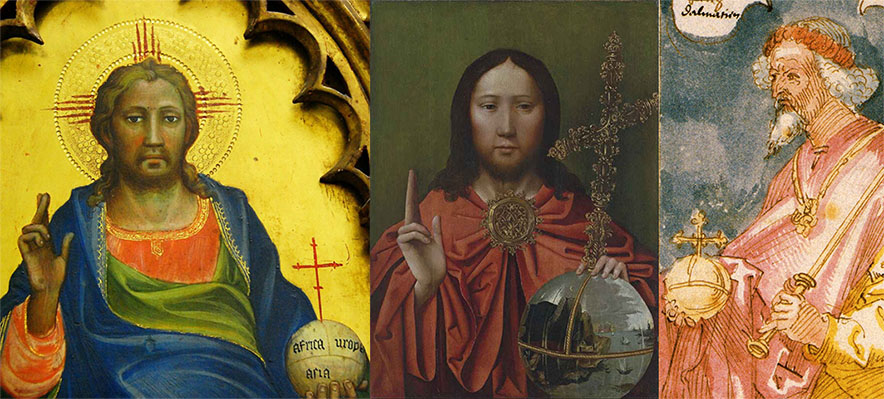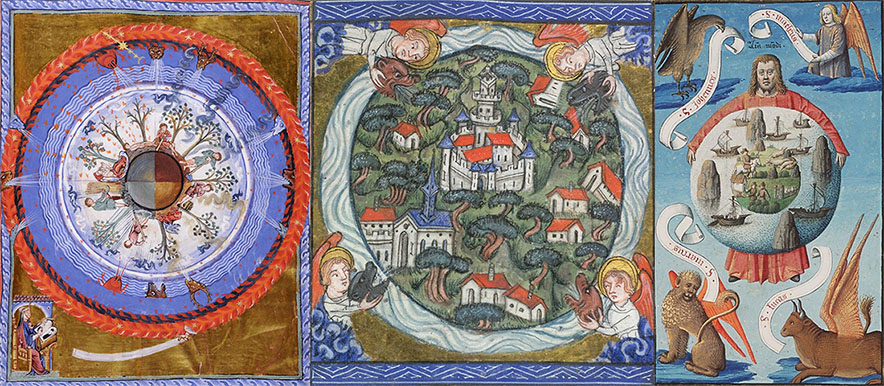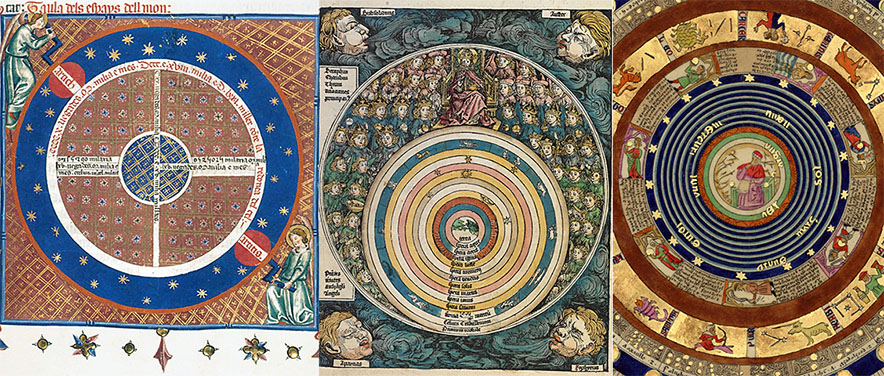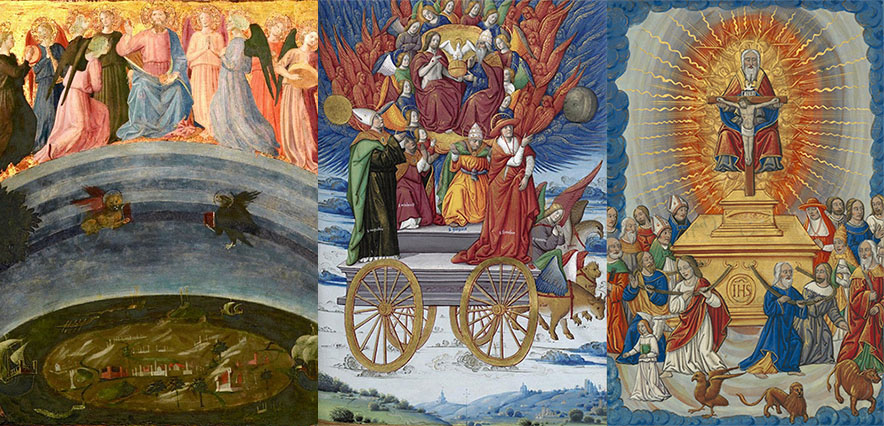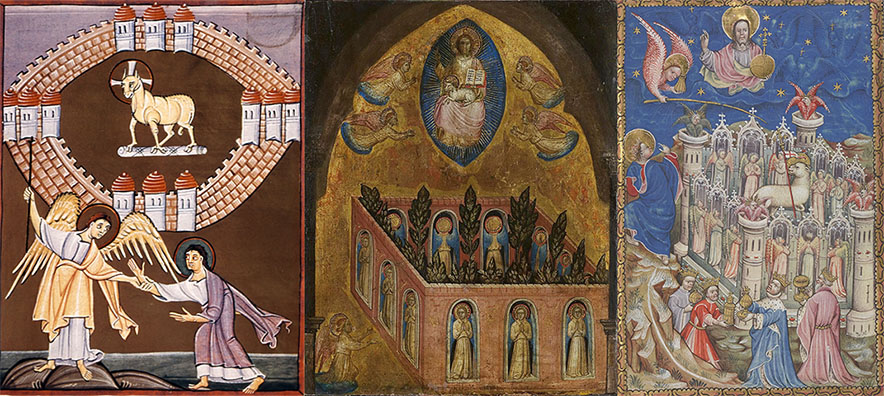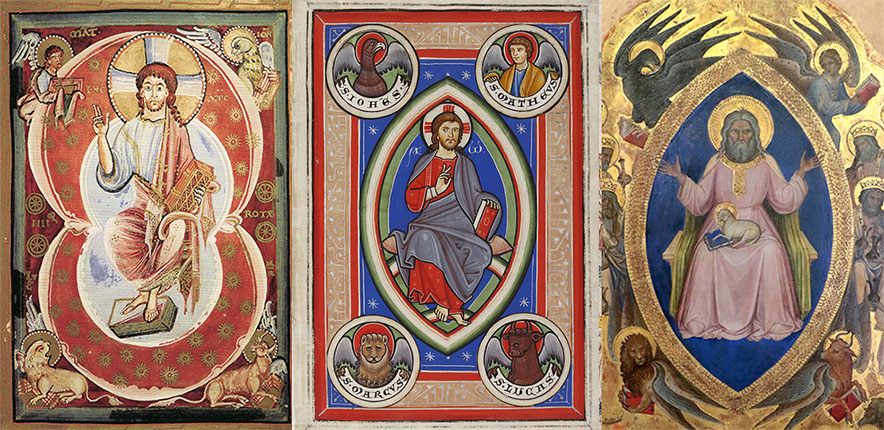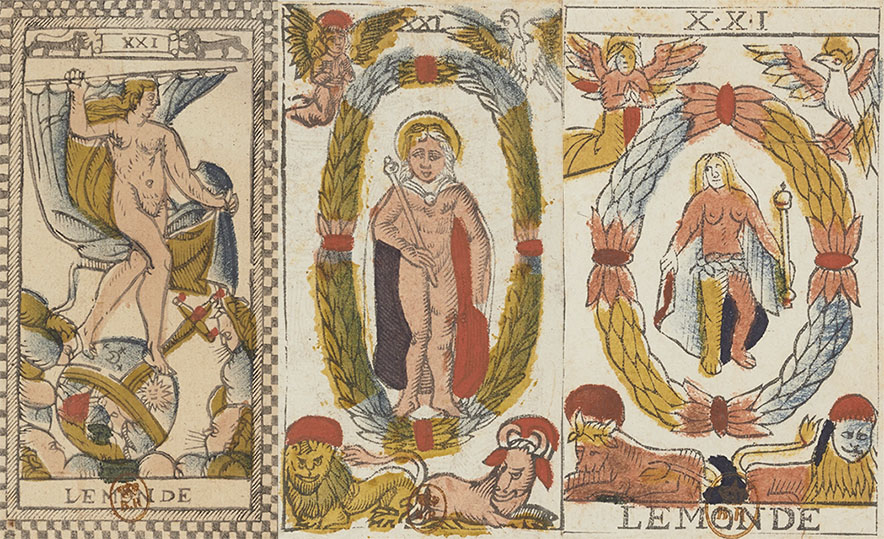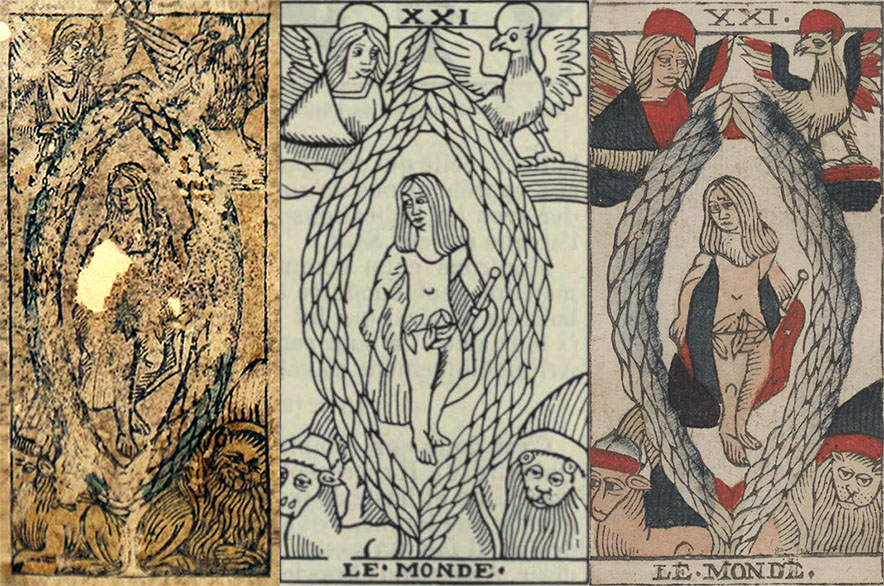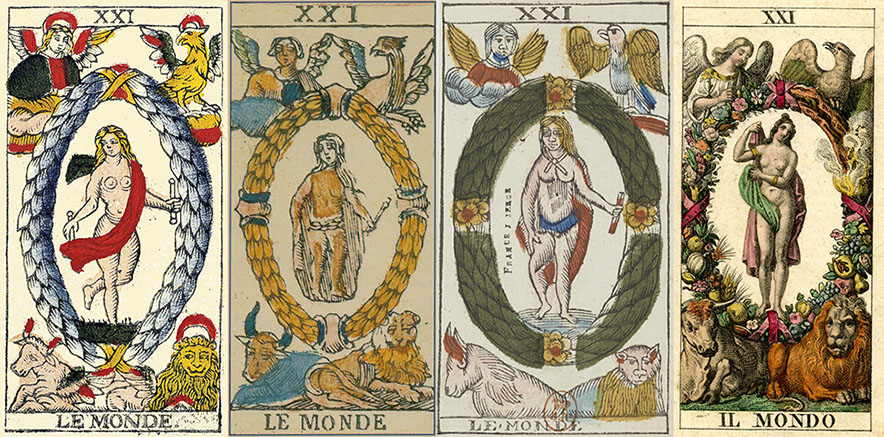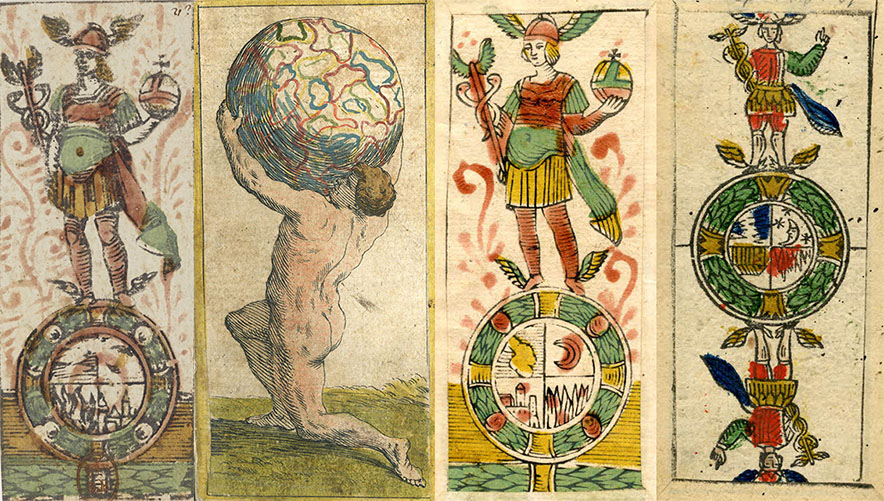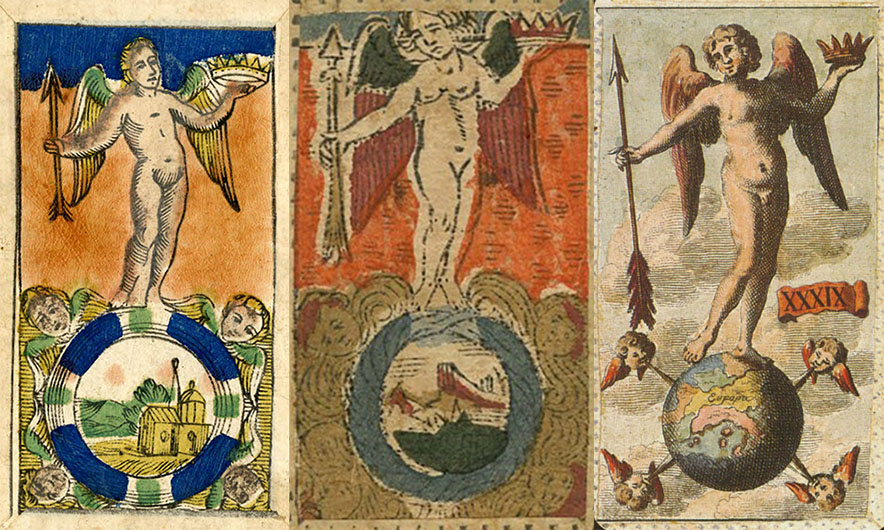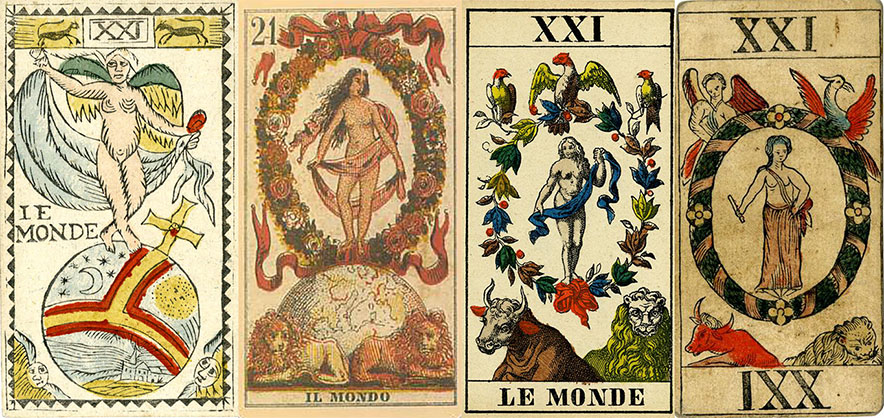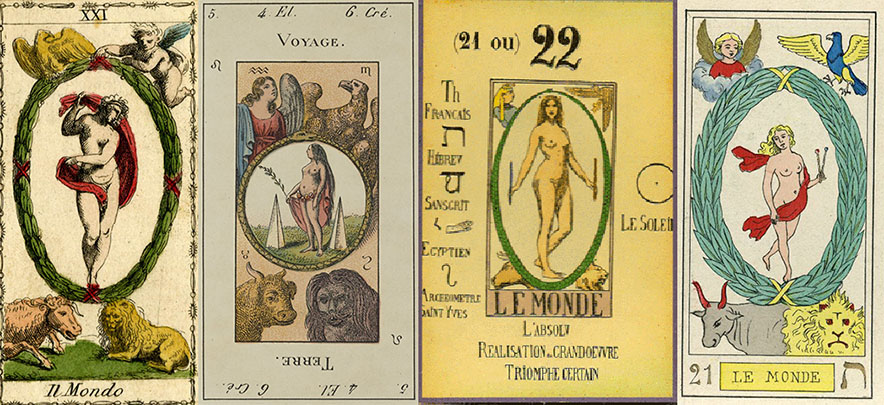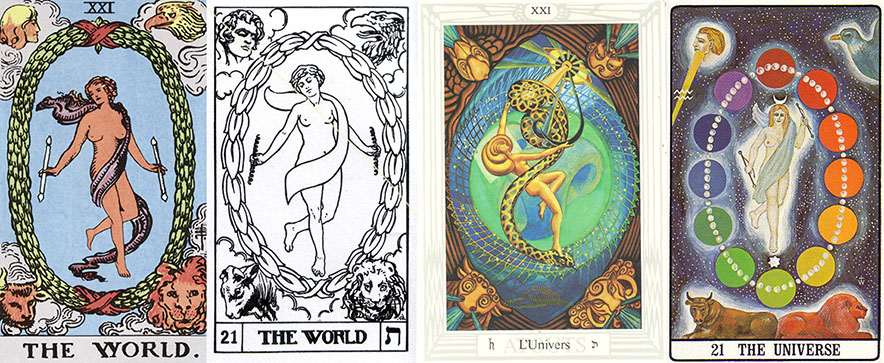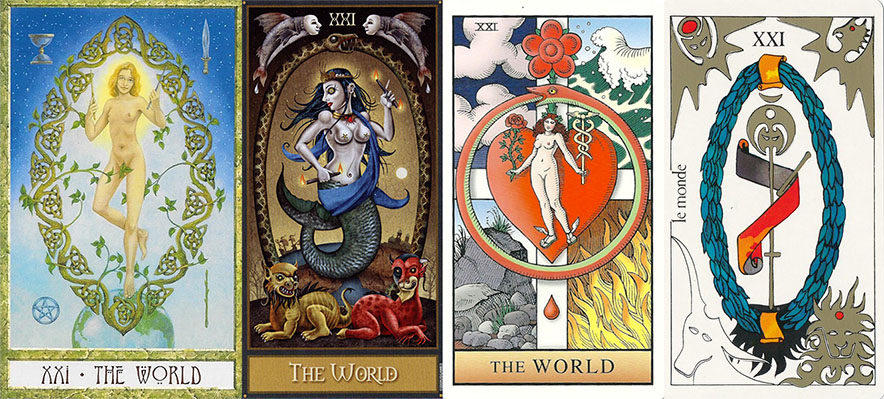THE TAROT WHEEL
EL MONDO - THE WORLD
The World is the last card of the Tarot Trumps. This card corresponds to the Triumph of Eternity, the last of the Trionfi of Petrarca. So, we begin this page with an image that combines both, a miniature representing the Triumph of Eternity, created in 1442 in Florence and attributed to Apollonio di Giovanni. On this image, we see God surrounded by two angels, sitting on a disk, representing the universe. We see only a part of the disk that represents the seven levels of Heaven, bordered by the fixed stars as the outermost layer and a landscape representing the Earth in the center. The landscape is surrounded by an ocean and topped up with a thick layer of atmosphere. In the Middle Ages and the early Renaissance, most people considered the Earth as the center of the universe, and the word 'world' indicated both the planet Earth and the universe. So, the World in Tarot stands for the Universe, from the beginning of the Creation up to Eternity. Let us see how this universe was represented on the 15th Century Trionfi and printed decks.
Six hand-painted World cards survived time, 3 Milanese cards and three Ferrarese cards. I do not present on this page, the card that is often considered as the 'World' card of the Visconti di Modrone Trionfi deck. As explained here, I consider this card as a representation of the Triumph of Fame. Let us start with the Ferrarese cards.
From left to right, we have first the World card of the Este Trionfi deck, made in 1473 at the occasion of the marriage between the 41 years old Duke of Ferrara and Modena, Ercole I of Este, and the 18 years younger Neapolitan princess Eleanor d'Aragon. The second card is from the so-called Charles VI deck, probably commissioned by the Ferrarese court, and presumably also during the reign of Ercole I of Este. However, it could be earlier, during the rule of his half brother Borso d'Este, who ruled over Ferrara from 1450 to 1471. The third card belongs to the Trionfi deck of Alessandro Sforza, who was Lord of Pesaro from 1444 to 1473. Again the attribution to Alessandro Sforza is not certain, it could also be commissioned by the Este family of Ferrara. Discussions are ongoing about which of these two cards is the eldest, while both cannot be dated, nor attributed, with precision.
The Este card shows a putto sitting on a cloud just above a disk of the world, that is carried on the wings of an eagle. The putto has an orb surmounted by a cross (called a Globus Cruciger) in his right hand and a wand in his left one. On the disk we see a hilly landscape with many towers in the same style as existed in that time in many Italian City States (like some still existing in Bologna today), and some trees. The landscape is surrounded by a dark blue band, on which we can distinguish waves, indicating that the band represents an ocean. On the second card, we see a woman standing on the disk of the world that is floating on some clouds. She has in her right hand a scepter and in the left one a golden disk that might represent an orb or maybe the backside of a mirror. On her head, a headdress in the form of a spiderweb, indicating that the woman represents a virtue, probably Prudence. On the disk, we see again a hilly landscape, this time with multiple walled cities. The landscape is surrounded by a green band. The next card is very similar to the second one, with some differences in the details. The woman lacks the headdress in the form of a spiderweb, The landscape consists now of some mountains with a small house in the foreground and another in the background. The landscape is surrounded by a band on which we see two towers, resembling those of a chess game, a house and some drawings that are difficult to identify.
The Milanese cards are different from the Ferrarese ones. From left to right, we have here first the World card of the Visconti Sforza deck. This deck has been commissioned around 1452-1454 by the Milanese ducal court. At that time, the Trionfi decks consisted of only 14 trumps. The deck has been extended to the new 22 trump structure, probably after 1475. The World card is one of these later cards. For the next two cards, we don't know who ordered them. The first one is part of the so-called Bonomi cards. This card was sold at Christies in 2008, when it was dated to the 16th Century. The third card is part of the so-called Guildhall cards. The image is a (bad) copy of an image in an old magazine, and the actual location of the card is unknown. In any case, both Bonomi and Guildhall cards are copies of the Visconti Sforza card, so let us describe this card a bit better. On the Visconti Sforza card, we see two naked and winged putti holding a disk in their hands. The landscape behind the putti consists of some dark mountains. On the disk, we see an image representing the New Jerusalem, referencing eternity and Paradise. This image is a direct reference to the Bible text Revelation 21:2, where an angel shows the new Jerusalem to saint John:
And I John saw the holy city, new Jerusalem, coming down from God out of heaven, prepared as a bride adorned for her husband.
The two other cards show exactly the same image. Now let us have a look at how the World is presented on the 15th Century printed cards.
From left to right we have the world cards of the Rosenwald sheet, the Budapest sheet and the Rothschild sheet. The three cards are part of uncut sheets found in the binding of old books and are dated to approximately the end of the 15th Century. The Rosenwald sheet was printed in Bologna or Florence, the Rothschild sheet in Bologna and the Budapest sheet is probably from Ferrara. On the Rosenwald card, we see an angel standing on a disk of the world. The sheet was probably rejected by the printer because it was printed in mirror. In her right hand, the angel has a sphere and in the left one a sword, very similar to the virtue of Justice in the Chapel of the Cardinal of Portugal in the Basilica di San Miniato al Monte in Florence (presented here). On the disk of the world we see a landscape with some buildings. The landscape is surrounded by a band made of laurel leaves. On the Budapest sheet, we see a cross-eyed looking angel standing behind the disk of the world that she holds in her hands. On the disk, we see a landscape with many buildings and water in the foreground. Around the disk a small white band. On the Rothschild card, that is one of the earliest Tarocchino cards, we see a human figure, representing the Roman God Mercury (the equivalent of the Greek God Hermes) standing on a disk of the world. He (or she) is wearing a cape and a winged helmet. In his right hand, a short staff with a winged orb and in his left hand a globus cruciger (an orb surmounted by a cross, see the art section here below). Usually, the God Hermes was presented with a short staff entwined by two serpents and surmounted by wings, called a caduceus. The disk of the world on which he is standing, is divided in four parts, the sky in the two upper parts (day on the left side and night on the right side) and the earth in the lower part (grass or flames on the left side and a tree on the right side). Another interpretation might be that these four parts represent the four elements (top left water, top right air, bottom left fire and bottom right earth). Around the disk, like on the Rosenwald card, a band of laurel leaves.
The World card not only stands for the planet Earth, but equally well for the Universe, Eternity, Paradise or God himself. It is one of the most complicated cards in terms of symbolism. It is not for nothing that in the series of fifty prints called the Tarot of Mantegna, created around 1465, not less than four cards are directly related to this subject:
The Tarot of Mantegna (that is neither a Tarot, nor created by Mantegna) is a series of 50 prints describing all physical and spiritual aspects of human life. This series is divides in 5 groups of 10 cards. The last group of 10 cards describes the physical and spiritual Universe, and it is directly based on the nine heavens described in the Commedia, written between 1303 and 1321 by Dante Alighieri. The first seven prints describe the first seven layers of heaven, each of them containing one of the seven known heavenly bodies (the Moon, the Sun and 5 planets). Here, we show the sixth layer of Heaven, representing the planet Jupiter. On this print, we see the God Jupiter is sitting in an almond shaped object, that reminds us the images of Christ in Majesty and the World card of the Tarot of Marseille (TdM), that will be presented later on this page. The fact of presenting Jupiter as Christ in Majesty, is to emphasize that he is the highest ranked figure in the pantheon of the Roman Gods (the Pantheon was a temple in classic Rome dedicated to all Gods). Jupiter is the equivalent of the Greek God Zeus, who was often symbolized as an eagle. According to the Greek mythology, Zeus visited regularly the Earth in the form of an eagle. On one of these visits, he kidnapped Ganymede, the most beautiful boy on Earth, to make him his cup bearer in Heaven. Ganymede is represented here by the small boy at the feet of Jupiter. The second card, here above, called Octava Spera, represents the eight' heaven, the layer of the fixed stars. Beyond the layer of fixed stars is the Primum Mobile, represented by the third card called Primo Mobile. According to Dante, this was the last physical layer and the origin of life, motion and time. Both the cards Octava Spera and Primo Mobile correspond visually to the 15th Century world cards, presented here above. On the last card, called Prima Causa, we see a drawing presenting the entire Cosmos as interpreted in the Middle Ages. Prima Causa can be translated as the first reason. The first reason is a concept of why we are here, and why the universe exists, to be short, a concept of God himself.
It is no surprise that the idea behind the World card in Tarot, described by four different cards in the Tarot of Mantegna, is represented in several ways in Medieval and Renaissance art. Let us start with simple representations of the world, continue with representations of the universe to end with representations of Paradise, Eternity and God himself.
The oldest representations of the world were rather simple. The first card on the left is a so-called T-O Mappa Mundi from a 12th Century manuscript. The drawing follows the description of Isidorus Hispalensis (better known as Isidore of Seville), written at the beginning of the 7th Century, when he was archbishop of Seville, in an etymological encyclopedia he created, called the Etymologiae. It represents the world map as a circle divided by a T in three continents (giving as such name to the T-O model), Asia, Europa and Africa. North is to the left. This same world model was used for centuries. The second image follows the same T-O model and is part of a manuscript called Livre du Tresor, written in the 13th Century by Latini Brunetto, and illustrated by Pierre Remiet in the 14th Century. Here we don't see the continents, but we can distinguish on the upper half the sky with the Sun on the left side and the Moon on the right side. On the lower half, we see a landscape on the left side and the ocean on the right side. The third Earth map, still in the same style as the T-O model of Isidore of Seville, is from a manuscript, dated to 1450, with the French translation, by Jean Corbichon, of a Latin text written by Bartholomaeus Anglicus called De proprietatibus rerum (On the properties of things). The disk of the world is now surrounded by an ocean, with God depicted on top of the page, surrounded by two angels. The depiction of a flat world surrounded by an ocean, like we have seen on the Este card, was wide spread in the Middle Ages:
The T-O model of the world was also represented upside down as an inverted T. In this case, there was a cross on top of the orb. We call this symbol a globus cruciger, the Latin expression for an orb with a cross. We did not see this in the 15th Century Tarot cards, but it did show up in younger Tarot decks, as we will see later on this page. Already in the Roman Empire, an emperor was often presented with an orb in his hands, to show that he was the mightiest ruler of the world. The Holy Roman Emperors put a cross on the globe, which gave rise to the globus cruciger. Nowadays, almost every European monarchy has a globus cruciger as one of the symbols of power of the monarch. The first image was created by Gherardo Starnina, a Florentine artist active at the end of the 14th and the beginning of the 15th Century. We see here Jesus Christ as Salvator Mundi, the savior of the world. He is blessing us with his right hand while holding the disk of the world in his left hand. The Earth is presented as an inverted T-O model, with North to the right. The second image is again Christ as Salvator Mundi, from an anonymous Flemish painter, made in the early 16th Century, probably in Bruges. Here, inside the globe, the world is represented as a very elaborate landscape. The globus cruciger was first used by the Holy Roman Emperors, so the third image, made by Albrecht Dürer in 1512, represents Emperor Sigismund, a Holy Roman Emperor who died in 1437, with the orb of power, the globus cruciger, in his right hand.
Let us go back to the representation of the Earth as a flat disk, surrounded by an ocean. The first image on the left, called the cycle of the seasons, was made by Hildegrad von Bingen, a German Benedictine abbess. It is from a manuscript called Liber Divinorum Operum Semplicis Hominis (the Book of God's works), written and illustrated by her between 1163 and 1173. We see on the illustration a disk of the world depicting the four seasons. Around the disk, a vast ocean and four groups of three winds blowing toward the disk. The second image is from a French manuscript dated to 1370 with as main subject the Apocalypse. Here we see the disk of the world surrounded by an ocean. On the disk of the world, we see a landscape with several buildings, exactly as on the hand painted Trionfi cards. In the four corners of the image, we see an angel, each of them holding one of the four winds in their hands. The last image, called Anima Mundi, is from a French manuscript dated to 1475. Here we see Jesus Christ holding the universe (again a disk of the world presented as a landscape surrounded by an ocean). In the four corners of the image, we see the four living creatures, symbolizing the four Evangelists. Their names written on a banner next to each creature. Matthew is represented by an angel, Mark by a lion, Luke by an ox and John by an eagle. On this image, we have various elements of the world card, as depicted in the Tarot of Marseille, presented later on this page.
People have always been fascinated by the concept of the universe, cosmology and the heavens. Thousands of images exist in medieval manuscripts trying to explain day, night, the planets and the stars. Here above three representative examples. The first image represents an Arsitotlean-Ptolemaic map of the universe, which is a detail from Ermengau of Bezier's Brevari d'Amor, created in the last quarter of the 14th Century. On the image, we see two angels turning perpetually the Earth axes to rotate the disk of the world to produce day and night. The second image is from the Nuremberg chronicles, published in 1493. Here we see the disk of the world surrounded by spheres of water, air, the moving celestial bodies, and so on, up to the premium mobile (see explanation above under the Mantegna prints). On top of the sphere representing the cosmos, we see God surrounded by the saints. The saints are ordered in three groups. The highest group of saints consists of the clergy, the next group of the nobility and the lowest group of the commoners. Outside the heavens, we see in the corners of the image the four winds. The last image is a detail of a celestial map, extracted from a Catalan atlas and dated to 1375. Here we see again the world disk surrounded by the celestial spheres up to the fixed stars. Outside the sphere of the fixed stars, there is an explanation of each of the moving spheres, followed by representations of the signs of the Zodiac.
We started this page with an illustration of the Triumph of Eternity. The first image, here above, is a detail of a painting by Francesco Pesellino, realized around 1450. This representation of the Triumph of Eternity has the same symbolism as the image on top of this page, with God, surrounded by angels, sitting on a disk of the world. On this disk of the world, we see a landscape with several cities. The disk is surrounded by an ocean, where we see various ships sailing. Above the disk, there is a thick layer of atmosphere. Here we see the symbols for the evangelists Mark and John, a winged lion and an eagle, both carrying a book. Above the atmosphere the different layers of Heaven before we arrive at the image of God sitting on his throne, surrounded by ten angels of which some are playing a music instrument.
The second image is from a French translation by Bernardo Lapini of the Triumphs of Petrarca, realized between 1500 and 1503 in Rouen. The name of the artist who made the drawings in not known. This image shows another way of depicting the triumph of Eternity. Very often we see the six Trionfi of Petrarca illustrated on a Chariot. Here we see the Trinity (God the father, the son and the holy ghost) sitting on a throne placed on a chariot. The throne is being carried by twelve angels representing the twelve apostles. In front of the throne, we see four saints. The Chariot is pulled by three winged animals, representing three of the four evangelists (St. Mark, St. Luke and St. John), that are guided by the fourth one, represented by an angel (St. Matthew).
The last image, in the same style with a chariot, is also from a French translation of I Trionfi from Petrarca, here translated by Simon Bourgouyn, when he was in the service of King Louis XII, who reigned between 1498 and 1515. On this image, we see God the father sitting in a mandorla, composed of small yellow angels. He is holding a cross, with his son Jesus nailed to it, in his hands. On the chariot, we see the monogram IHS, that is an abbreviation of Jesus name, when written in Greek (ΙΗΣΟΥΣ). The chariot is pulled by four people, who are each preceded by one of the four creatures representing the four evangelists. Next to the chariot, there are twelve men, representing the twelve apostles of Jesus.
Before ending the art section with depictions specifically of God himself, let’s have a look at images of Paradise as the New Jerusalem. This is described by St. John in the Book of Revelations of the New Testament. This is a symbol that we encountered already in the Visconti Sforza Trionfi deck. The New Jerusalem is described in detail in Revelation 16. According to the Bible, the New Jerusalem is a square city made of jewels, 2400 km (1400 miles) long and wide, with walls over 65 meters (216 feet) thick. In every wall, there are three gates, each made from a single pearl, with an angel at every gate. There is no temple in the city, while God himself is there, as is the Lamb of God, representing Jesus. One of the oldest illustrations we have of the New Jerusalem is from the Bamberg Apocalypse, an illuminated manuscript made in the early 11th Century. Here we see an angel showing the New Jerusalem to St; John. The New Jerusalem is presented as a walled city with the Lamb of God inside. We see twelve towers representing the twelve gates and God's Lamb in the center of the city. The second image was created by Jacobello Alberegno in the last quarter of the 14th Century. Here we see the square New Jerusalem, with in every wall three gates and in every gate a praying angel. The New Jerusalem looks here like a medieval garden with many trees. Above the New Jerusalem, we see God with Jesus, represented by a lamb, on his knees. He is surrounded by four angels, and another angel is kneeling in front of the city walls. On the third image we see again a walled city with God's lamb in the center and an angel in front of each of the three gates in all four walls. This image comes from a Dutch manuscript from the 14th Century. Also here, God is present above the city. He is holding a globus cruciger as a symbol of his power. In the city, we see the lamb of God who has a staff with a cross on top and a white banner with a red cross, symbolizing the resurrection of the death of Jesus. Left of the city we see St. John with above him an angel who shows him the holy city.
Before returning to the Tarot cards, there is one subject, we encounter on some world cards, that we did not explore yet, Christ in majesty. This theme was described in detail in Revelation 4:1-11. Here, God is described as sitting on a throne, surrounded by four beasts, a beast with the head of a lion, a beast with the head of a man, a beast with the head of a calf and a beast with the head of an eagle. These beasts are similar to the four living creatures described by Ezekiel in the Old Testament (Ezekiel 1:5-10), although there, all four living creatures have four heads, one of a man, one of a lion, one of an ox and one of an eagle. It is only in the second Century, that a Greek Bishop, St. Irenaeus associated the four beasts with the four evangelists, Matthew with a man, John with a lion, Luke with an ox and Mark with an eagle. Two centuries later, the Cypriot bishop Epiphanius proposed for the first time to switch John and Mark, an association that would become the standard one used during the Middle Ages and the Renaissance.
The first image on the left is Christ in majesty, taken from the Hitda Codex, an evangeliary commissioned in 1020 by Hitda, a German woman, abbess of Meschede. Here the throne of Christ is presented as an open shell. Around him four winged creatures, on the top side an angel and an eagle, and on the bottom side a lion and an ox. The figure on the throne is blessing us and next to him the Christogram XPC, identifying him as Jesus Christ. He and the four creatures all have a closed book. The second image is from a German psalter dated to 1250. On this image, Christ is sitting on a throne within an almond shaped figure, called a mandorla, with a closed book in his hand. The four winged creatures have each a banner with the name of the associated evangelist. The last image is a detail of the central panel of a polyptych representing the Apocalypse, made by Jacobello Alberegno in the last quarter of the 14th Century. Here it is God himself, who is sitting on a throne within a mandorla. On his knees, we see a closed book and Agnus Dei (the Lamb of God). The winged creatures have each three wings and an open book, except the lion, who has a closed book.
In this Art section, we have seen how the different elements used on the World cards of the Tarot, were depicted in Medieval and Renaissance art. Now, let us have a look at how the World card itself developed through the ages. We'll start, as on several other pages, with the World card of the three decks that survived time and were published in the 16th Century in Paris:
The first card is from the anonymous Tarot of Paris made in the first half of the 17th Century, somewhere around 1625. We see a naked figure standing on a globus cruciger. Inside the globe we see a landscape in the lower half of the globe, with in the upper half two quarters with at left the night and at right the day. The four winds are blowing at the globe. The second card is from the Vievil Tarot, made around 1645. Here, the image changes radically regarding the 15th Century Italian cards, and we see a naked Christ standing inside a mandorla made of laurel leaves. The mandorla is surrounded by the four living creatures representing the four evangelists. The last card is from the Noblet Tarot, the oldest-known Tarot of Marseille. The card is very similar to the Vievil card, but here the central figure does not have an aureole. It is not even sure if this figure is a man or a woman. The question is now, is the Noblet Tarot really the first TdM deck, or are older decks existing?
Here above, we see three cards, of which the images are virtually identical. The first card (thanks Ross, for this nice picture) was found while cleaning a dug well in the Sforza castle in Milan. Like on the Vievil card, we see a number on top, but there is no title on the bottom, which leads to the conclusion that this card may be older than its French counterparts. The card has been dated to the 16th or 17th Century, so it might belong to an Italian deck that served as a model for the Tarot of Marseille decks. Next to this card, a reproduction by Larousse in 1919 of the Tarot of Nicolas Rolichon, according to them a copy of a 17th Century Lyonese Tarot deck. Unfortunately for us, the actual location of the Rolichon deck is not known (if it still exists). The card is a typical TdM type I deck. The third card is also from Lyon, and nearly identical to the two other cards. This card was produced by Jean-Pierre Payen in 1713. When we look at the Sforza castle card that has no title, it seems logical to suggest that the Tarot of Marseille was created originally in Italy, and not in France (and certainly not in Marseille). The Lyonese cards were apparently produced at a later date, and they were very probably copies of a deck similar to the one of which some cards have been found in the well of the Sforza castle. In that case, the typical type I Tarot might be older than the Tarot of Jean Noblet, who did not copy strictly the earlier produced cards.
The Tarot of Marseille is, in general, divided in two groups, type I decks and type II decks. The World card is one of the cards where the difference between the two groups is the most obvious. Where in the type I decks, the figure within the mandorla seems to be a long-haired man, in the type II decks, this figure represents clearly a woman. She is crossing her legs as if she is dancing. The lion and the ox have clearly distinguishable wings, where on the type I decks, they are invisible. Other decks of the TdM family, like the Besançon Tarot and the Tarocchi decks, usually mixed characteristics of both types of decks. The first card on the left is the oldest-known type II deck. It was printed in 1709 by Pierre Madenié in Dijon. The second card is from an Italian Tarocchi deck, it was printed in 1780 by Giacomo Zoni in Bologna. Because the deck is using French titles, we are certain that this deck used as a source of inspiration, a French type I TdM deck and not the maybe older Milanese deck. On the mandorla we see some decorations as on the deck from Jean Noblet. Remark that the four creatures don't have aureoles, that are standard on French TdM decks. The third card is from a Tarot from the Besançon type. It was realized at the beginning of the 19th Century by Jacob Jerger in Besançon. On this card, that is very similar to the Bolognese card, we see mainly type I characteristics. The last card is from a Tarocco Sopraffino deck, created in 1830 by Carlo della Rocca and printed on the Gumppenberg press in Milano. The printing techniques have been much improved, permitting to della Rocca to make a very personal interpretation of a TdM deck. Here also, we clearly have a woman standing in the mandorla, although she isn't dancing.
While the French TdM choose to present the World card in the style of Christ in Majesty, the Italian decks continued to use the World disk as the main symbol on the card. Here above four Tarocchino of Bologna cards, the oldest type of deck in the Tarot family with a standardized illustration. The first card is from an anonymous Bolognese card maker, and has been dated to the early 17th Century. The image is virtually identical to the one on the Rothschild sheet. We see the God Mercury (Hermes), the messenger of the Gods, standing on a disk of the world, with a caduceus, the staff of a messenger, in his right hand and in his left one a globus cruciger, the orb of power. On his head a winged helmet, and on his feet also wings. The disk of the world is divided in four parts, that we will describe when we come to the third card. The second card is from a non-standard Tarocchino deck, designed and printed around 1665 by Giuseppe Maria Mitelli, and commissioned by the wealthy noble Bentivoglio family. Here we see Atlas, one of the Titans in the Greek mythology, holding the globe in his hands. In effect, Atlas took part in a war against Zeus, and as punishment he was condemned to hold aloft the Heavens. The third card was made, according to the British Museum that is conserving this deck, by Antonio de Maria between 1725 and 1770. The card is identical to the first card presented here, but it is easier to identify the illustrations in the four quarters of the world disk. In the upper half, we see on the left side a cloud in the sky and on the right side the moon. In the bottom half we see on the left side some buildings and on the right side grass (or flames). In the year 1770, the standard Tarocchino cards became double-headed, to facilitate game playing. The fourth card is an anonymous example of such a deck, published in the early 18th Century. Remark that the double-headed cards preserve most of the elements present on the older cards.
The next series of cards is based on the so-called Minchiate decks, which originated in Florence. Here above three cards, published in the 18th Century. The first is from a Minchiate deck produced in Bologna, the second from a Tarocco deck produced in Lucca (that was not a Minchiate deck but inspired by), and the third one, dated to the end of the 18th Century, produced in Florence. On all three cards we see, like on the Este deck, a naked Cupid, this time with an arrow in his right hand and a crown in his left one, standing on a disk of the world, that is surrounded by the four winds. On the third card, the world disk has become a globe with a map.
Not all decks followed exactly the traditional imagery. The first card here above is from a Belgian Tarot, made by Jean Gisaine in the 18th Century in Brussels. On almost all cards of this type of decks, the Belgian Tarot follows strictly the Tarot of Vievil, but here they used the World card of the Tarot of Paris, presented earlier on this page, as a model. Here we see a naked angel standing on the disk of the world, that is presented as a globus cruciger. In the lower half of the orb, we see a landscape, and in the two upper quarters, we see on the left side the moon representing the night, and on the right side the sun, representing the day. In the bottom corners of the card, we see two faces, that might represent two of the four winds. The second card is from the Perrin Tarot, a deck produced around 1865 by Claudio Perrin in Turin. Here we see a naked woman is standing in an aureole of flowers that rests on a globe. In front of the globe, we see two lions. Perrin used the Soprafino deck, presented earlier on this page, as his source of inspiration, but we have the impression that he did not understand very well the symbolism behind the world card. The third card has a similar problem. It is from the 1831 Swiss 1JJ Tarot, printed in the card factory of Johann Georg Rauch, who designed the cards. He used as source of inspiration the Besançon type decks, but on the world card he replaced the angel and the eagle with three eagles. The last card is from a Tarot deck made in 1797 by Franz Jacob Leipert in Stift Kempten, a small town, close to the Swiss border in Germany. For this deck, the card maker also uses the Besançon style decks as a model. The particularity of this card is that the woman is not naked anymore. The lower part of her body is covered by a long skirt.
Our conclusion is, that in the 19th Century, several card makers did not understand very well the symbolism behind the Tarot cards. The cards can be identified, but various details of the symbolism are gone.
However, most 19th Century card makers did respect the traditional symbolism. The first card on the left is called the Tarot of Lombardy. It was published by an anonymous card maker in 1810 in Milan. All symbols of the TdM World card are present here, but the angel was replaced by a cherub. In the same era, at the end of the 18th Century, French occultists started to link to Tarot to Egypt. One of these occultists, who called himself Etteilla, designed his proper Tarot deck, that 'corrected' the errors in the TdM decks. The second card is from this deck. In the center of the card, we see a woman standing between two pyramids. The four living creatures are now linked to the signs of the Zodiac, and the number of the card became 5. In fact, Etteilla changed completely the order of the cards. For him, the first card represented the Chaos before the Creation of the World. The next seven cards represent the seven days of the Creation. They are followed by the four cardinal virtues and 9 following trumps were representing events in human life. The Fool becomes number 78 in this deck. Within the days of creation, Etteilla placed the first day as number two and the seventh day as number eight. In between these cards, he rearranged the cards to take, according to him, a more logical sequence. So cards numbered 2 to 5 represent the four elements, card 6 the creation of day and night and card 7 the creation of vegetation and birds. The element earth was for him the last of the four elements, so it was numbered 5. He also replaced the mandorla by a Ouroboros, a snake eating its tail, that is a symbol for the cycle of life, death and rebirth. The Ouroboros is an ancient Egyptian symbol. The oldest-known depiction of this symbol dates from 1400 BC, and was found (many years after Etteilla died) in the tomb of the Egyptian Pharaoh Tutankhamun.
After Etteilla, another French occultist, Eliphas Levi, preferred to keep the numbering of the TdM, and he attributed Hebrew letters to each card. The only difference in his numbering is that he placed the Fool as number 21 just before the World that became attributed the number 22. The third card was designed at the end of the 19th Century by a French occultist who called himself Papus. He followed Levi in the attribution of the Hebrew letters, but he was not so sure about the numbering. So, his World card is numbered (21 or) 22 and the Fool 0 (or 21). Otherwise, his card follows the symbolism of the TdM type II World cards. Around the same time as Papus published his card, the Swiss occultist Oswald Wirth, living and working in Paris, designed a trumps only Tarot deck. The card follows again the TdM symbolism, and the attribution of Levi of the Hebrew letters to the Tarot trumps. Like on the Lombardy Tarot, he depicted the angel as a winged child.
At the end of the 19th Century, British occultists became interested in the work of the French occultists with the Tarot. Especially the Hermetic Order of the Golden Dawn embraced the Tarot as an occult tool, and several members of this order created Tarot decks in agreement with their vision. All four decks presented here above were published by former members of the Golden Dawn. The first card on the left was created by Pamela Colman Smith under the spiritual guidance of Arthur E. Waite and was first published in 1909. The symbolism on the World card is strictly the same as on TdM decks. The second card is called the B.O.T.A. Tarot and is published by Paul Foster Case in 1947. As stated here above, Eliphas Levi placed the Fool at number 21. The Golden Dawn placed the Fool as the first card and reassigned the Hebrew letters. So on all cards, the letters between the French and British occultists are different, except for the last card, the World, that is assigned in both systems the letter Tav (ת). The B.O.T.A. Tarot deck was the first deck that indicated this association on the cards. The third card was also designed in the forties of the last century, but it was only published in 1969, long after the death of its creators. This deck was made by Frieda Harris under the guidance of Aleister Crowley. The symbolism on this deck is much more elaborate than on the previous decks, and it became very fast one of the most popular Tarot decks. The last card is from the Golden Dawn deck. The deck was created by Robert Wang under the guidance of Israël Regardie, who published the deck in 1977. According to Regardie, his deck follows strictly the guidelines of the Golden Dawn Order, kept secret since the start of the Century. Both Crowley and Regardie call this card the Universe. Despite the occultist symbolism they put in this card, the original TdM model rests easily recognizable.
And now, we arrive at the end of our journey through Tarot history, accompanied by the World card, and also at the end of my series about the individual trump cards. Due to the workload in my daily life, it took me some five years to achieve these series. To end this series, I will show you some modern Tarot decks that I bought. 90% of the decks I have bought are reproductions of historical decks, but sometimes I could not contain myself to buy a modern Tarot. Here above the World cards of some of these modern decks that I bought.
The first deck is the World card of the DruidCraft Tarot. The deck was conceived by Philip & Stephanie Carr-Gomm and illustrated by Will Worthington. It was first published in 2004 in the UK and one year later in the USA. When I was a student, I bought a black and white version of the RWS deck, but I was not really inspired by this deck. In 2009, I was working in Senegal and I had rented a house on the island of Gorée. On this mythical island, I came in contact with a French tarologist, who renewed my interest in the Tarot. So, I started to buy Tarot decks. The first deck I bought, well before I started to dive into the history of Tarot decks, was the DruidCraft tarot, a beautiful deck, inspired by Celtic traditions. This deck is built upon the RWS tradition, but using also the imagery of older decks and melting them with Celtic Wicca. On the World card we see a naked woman in the style of the TdM type II decks within a mandorla. The four creatures have been replaced by the four suit symbols, and the mandorla is resting on the globe.
The second card is from the Deviant Moon Tarot, a deck that has always intrigued me because of its strange and powerful images. It was published in 2011 by Patrick Valenza. In 2018, I attended a Tarot workshop in a village in the South Western part of France, and here they had one deck of the borderless edition for sale. I jumped on the occasion and I bought this beyond beautiful deck. I cannot say that I understand fully its symbolism, with two flying fishes in the upper corners of the World card, but I really adore this deck.
The third card is from the renewed edition of the Alchemical Tarot. This deck was created by Robert Place in 1995 and the renewed edition was published in 2007. In 2022, the 6th edition of this deck will be on sale. Several years ago, I was on a Tarot journey in Italy. Here I visited the Museo dei Tarocchi in Riola, at some 45 km of Bologna. I was received very well by Morena, who gave me a fabulous tour in her Tarot museum. At the end of the tour, she showed me some decks for sale. One of it was the Art Edition of the Alchemical Tarot that Robert Place himself had left in the museum, while he visited it some time before me. I could not resist and bought this beautiful deck. Like on the deck of Etteilla, the mandorla was replaced by an Ouroboros. Here, in the four corners of the card, we see the four elements.
The last deck is the World card from the Tarot de la Rea, an extremely stunning interpretation of the Tarot of Marseille. The deck was created by a French artist called Alain Bocher, who started the development of this deck in 1960 and published it in 1982. I found this deck on the Internet and felt immediately in love with it. All Tarot de Marseille cards are transformed in beautiful golden and silver silhouettes. I managed to buy this deck, with the edges gilded with fine gold, directly from the artist. It was, it is, and it will always be one of my favorite Tarot de Marseille decks.
And here ends our journey through the individual Tarot cards, with one of the most complicated and intriguing cards, the World. The representation of this card started as a flat world surrounded by an ocean, representing all the known universe, to finish as an interpretation of Christ in majesty, with Christ replaced by a naked woman, maybe representing the virgin Maria. The card continuous to intrigue modern Tarot card makers, who interpret the card in their own way. The World card represents the end of a cycle, the achievement of the ultimate goal, eternal peace and love. I thank everyone who loved this series, and especially those, who have sent me his or her appreciation.
